Class 7 Science Chapter 11 NCERT Based Activity - Light: Shadows and Reflections
Activity 11.1: Let us investigate
Activity Description:
- Take three matchboxes and make a hole in the inner tray of each matchbox, exactly at the same position.
- Arrange these three matchboxes in a straight line. Make sure that all three holes are exactly at the same height and are in a line as shown in Fig. 11.4.
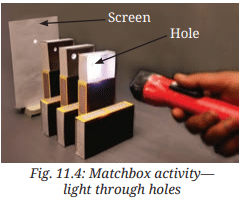
- Place a torch light on one side of the matchboxes, ensuring that its lamp is at the height of the holes.
- Place a cardboard (screen) on the other side of the matchboxes and obtain a bright spot on it. (You may need to slightly adjust the heights of boxes.)
Q: Move one of the matchboxes slightly to a side or up and down. Are you able to obtain the light spot on the screen now?
Ans: When one of the matchboxes is moved slightly to the side or up and down, the holes are no longer aligned in a straight line. As a result, the light from the torch cannot pass through all three holes to reach the screen, and you will not be able to obtain the light spot on the screen. This demonstrates that light travels in a straight line.
Activity 11.2: Let us explore
Activity Description:
- Caution—Use a lighted candle under adult supervision only.
- Take a long hollow pipe of some flexible material and align it so that you can see the candle flame as shown in Fig. 11.5a.
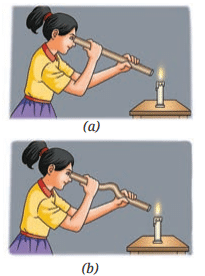 Fig. 11.5: Viewing candle flame through (a) a straight pipe (b) a bent pipe
Fig. 11.5: Viewing candle flame through (a) a straight pipe (b) a bent pipe
Q: Now, bend the pipe and try to see the candle flame again (Fig. 11.5b). Can you still see it?
Ans: When the pipe is bent, you cannot see the candle flame through it. This is because light travels in a straight line and cannot bend around corners inside the pipe. When the pipe is straight, the light from the candle flame travels directly through it to your eye, but bending the pipe interrupts this straight path, preventing the light from reaching your eye.
Activity 11.3: Let us experiment
Activity Description:
- Collect objects made of different materials. Also, you will need a torch.
- List the materials of the objects in Table 11.1 and classify them into transparent, translucent, and opaque (In the chapter ‘Materials Around Us’ in the Grade 6 Science textbook Curiosity you learnt to classify materials into transparent, translucent, and opaque, depending on how you could see through them).
- Go to a dark room, turn on the torch, and place it at such a position that you get a spot of light from the torch on a wall. Or you may place a cardboard screen as shown in Fig. 11.6 and get the spot of light on it.
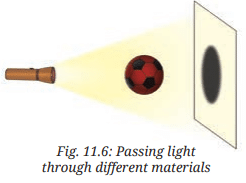
- We will now conduct this activity in two parts—prediction and observation.
- Repeat this for all the objects.
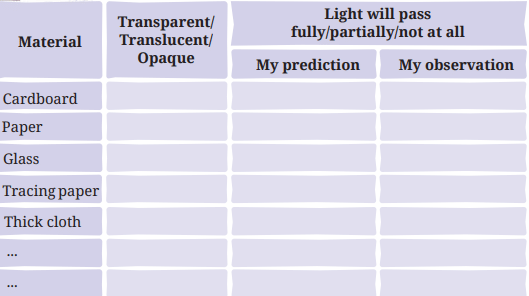
Q: Predict what will happen if you hold an object in front of the light coming out of the torch. Would you continue to see the spot of light on the screen? Note your prediction in Table 11.1.
Now, actually place the object between the torch and the screen. Does light pass through the object? Note your observation in Table 11.1. Was your observation the same as your prediction? What conclusions could you draw?
Ans:
- Prediction:
- For transparent materials (e.g., glass), predict that light will pass almost completely, and the spot of light will still be visible on the screen.
- For translucent materials (e.g., tracing paper), predict that light will pass partially, resulting in a dimmer or diffused spot of light.
- For opaque materials (e.g., cardboard, thick cloth), predict that light will not pass through, and the spot of light will not be visible; instead, a shadow may form.
- Observation:
- Transparent materials (e.g., glass): Light passes almost completely, and the spot of light is visible on the screen.
- Translucent materials (e.g., tracing paper): Light passes partially, creating a dim or diffused spot of light on the screen.
- Opaque materials (e.g., cardboard, thick cloth): Light does not pass through, and a dark patch (shadow) appears on the screen instead of the light spot.
- Comparison and Conclusions:
- If predictions match observations, it confirms the understanding of how light interacts with different materials.
- Conclusions:
- Light passes almost completely through transparent materials.
- Light passes partially through translucent materials.
- Light does not pass through opaque materials, resulting in a shadow where light is blocked.
Activity 11.4: Let us explore
Activity Description:
- Collect some opaque objects of different shapes and sizes.
- Repeat Activity 11.3, but this time, carry out the actions mentioned in the first column of Table 11.2.
- Observe the shape and size of the shadow on the screen for each of the actions.
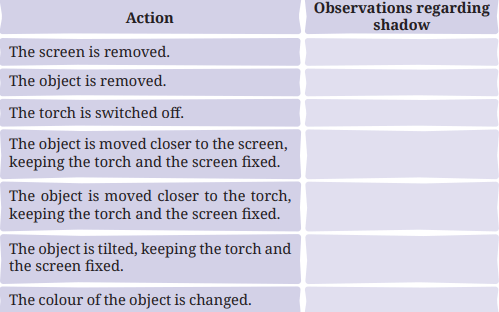
Q: Did the shadow form in all cases? Was the shape and size of the shadow the same as the object?
What conclusions do you draw from this activity? What do we need to observe a shadow? Does the colour of the shadow change when the colour of the object is changed?
Ans:
- Shadow Formation and Characteristics:
- Shadows form when an opaque object blocks light from reaching the screen. In all cases where an opaque object is placed in the path of light, a shadow is observed.
- The shape of the shadow generally resembles the outline of the object, but the size and sharpness depend on the object’s position relative to the torch and screen:
- When the object is moved closer to the screen (torch and screen fixed), the shadow becomes smaller and sharper.
- When the object is moved closer to the torch, the shadow becomes larger.
- When the object is tilted, the shadow’s shape may distort but still reflects the tilted outline.
- If the screen is removed, no shadow is observed because a surface is needed to display the shadow.
- If the object is removed, no shadow forms, and a bright spot of light appears on the screen.
- If the torch is switched off, no light is emitted, so no shadow forms.
- Conclusions:
- To observe a shadow, you need:
- A source of light (e.g., torch).
- An opaque object to block the light.
- A screen (e.g., wall, cardboard) to display the shadow.
- The colour of the shadow does not change when the colour of the object is changed. Shadows are always dark (typically black or grey) because they represent the absence of light, regardless of the object’s colour.
- To observe a shadow, you need:
Activity 11.5: Let us investigate
Activity Description:
- Find a shiny flat steel plate or a plane mirror, that is, a mirror that is flat and not curved.
- Take it outside and let the sunlight fall on the shiny surface. What can you do to redirect light on the wall on which the sunlight is not falling directly?
- Turn the shiny plate or mirror in different directions to redirect the light onto a wall or a nearby surface (Fig. 11.8). Do you see a spot of light on the wall? Does it mean that the shiny plate or mirror has changed the direction of light?
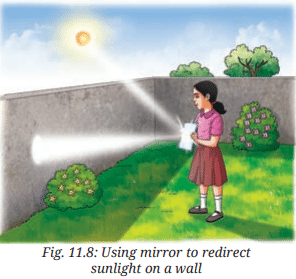
- Now, tilt the shiny plate or mirror in different ways and observe the light spot on the wall. Does it change position? Notice how light always travels in straight lines and changes direction when it falls on the shiny plate or mirror.
Ans:
- Redirecting Light:
- To redirect sunlight onto a wall where sunlight is not falling directly, hold the shiny steel plate or plane mirror at an angle so that sunlight strikes its surface and reflects toward the desired wall.
- Observation of Light Spot:
- Yes, a spot of light is observed on the wall when the mirror is positioned correctly. This indicates that the shiny plate or mirror has changed the direction of the sunlight, reflecting it onto the wall.
- Tilting the Mirror:
- When the shiny plate or mirror is tilted in different directions, the position of the light spot on the wall changes. This is because the angle of reflection changes with the tilt, redirecting the light to a different location. The light continues to travel in straight lines, but the mirror alters its path.
Conclusion: The shiny surface or mirror reflects light, changing its direction, which is known as the reflection of light.
Activity 11.6: Let us experiment
Activity Description:
- Take a plane mirror with stand, a torch, a comb, a sheet of white paper, and a strip of black paper.
- Using the black paper, close all openings of the comb, except for one to make a thin slit.
- Spread a white paper on a table, hold the comb perpendicular to the sheet of paper and shine the torch light on the slit. Adjust the comb and torch slightly till you see a thin beam of light along the paper which has passed through the slit (Fig. 11.9a).
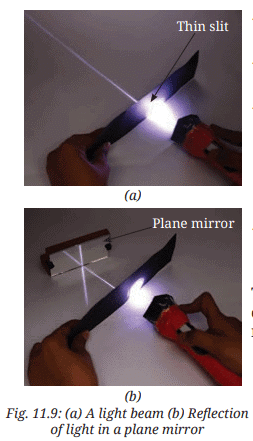
- Now, place the mirror in the path of the light beam while keeping the comb steady (Fig. 11.9b). What do you observe?
Ans: When the plane mirror is placed in the path of the thin beam of light (created by shining the torch through a slit in the comb), the light beam’s path changes. The beam reflects off the mirror and travels in a new direction, forming a reflected beam visible on the white paper or another surface. This demonstrates that a mirror causes the reflection of light, altering its direction while maintaining its straight-line path.
Activity 11.7: Let us experiment
Activity Description:
- Take a plane mirror and a pen or some other object.
- Place the pen in front of the mirror as shown in Fig. 11.10.
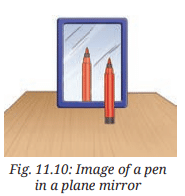
- What do you see in the mirror? It appears as if a similar pen is placed behind the mirror. The pen which appears behind the mirror is the image of the pen formed by the mirror. The pen itself is the object.
- Now, move the pen to different positions in front of the mirror and compare the sizes of the images of the pen at each position.
- Are the two sizes the same? The image formed by a plane mirror is of the same size as the object.
- Again, move the pen to different positions in front of the mirror and observe if the image is upright at each position.
- Does the tip of the pen appear on top at each position? An upright image is called erect. An image formed by a plane mirror is erect.
- Now, place a screen vertically behind the mirror. Move it around. Do you get the image on the screen? Repeat this by placing the screen in front of the mirror.
Ans:
- Observation in the Mirror:
- When the pen is placed in front of the plane mirror, an image of the pen appears in the mirror. It looks as if an identical pen is located behind the mirror.
- Size Comparison:
- The size of the image in the mirror is the same as the size of the actual pen, regardless of the pen’s position in front of the mirror. The image is always of the same size as the object.
- Orientation of the Image:
- The tip of the pen appears on top in the image at all positions, indicating that the image is upright (erect).
- Image on the Screen:
- The image formed by the plane mirror cannot be obtained on a screen, whether the screen is placed behind or in front of the mirror. This is because the image in a plane mirror is virtual, formed by the apparent intersection of reflected rays, not by actual light rays converging on a screen.
Conclusion: The image in a plane mirror is of the same size as the object, erect, and virtual (cannot be projected onto a screen).
Activity 11.8: Let us experiment
Activity Description:
- Stand in front of a plane mirror and look at your image (Fig. 11.11). Notice how far it appears to be from the mirror.
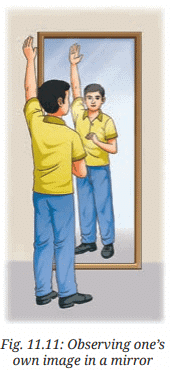
- Now, stand close to the mirror. Is the image also closer to the mirror?
- Stand at different distances from the mirror and notice how far the image appears to be from the mirror in each case. Do you find any relation between your distance from the mirror and the distance of your image from the mirror?
- Raise your left arm. Which arm does your image raise?
- Touch your right ear. Which ear does your image touch?
Ans:
- Distance of the Image:
- When you stand in front of the plane mirror, the image appears to be as far behind the mirror as you are in front of it.
- Image Distance When Closer:
- When you stand closer to the mirror, the image also appears closer to the mirror, maintaining the same distance behind the mirror as you are in front.
- Relation Between Distances:
- The distance of the image from the mirror is equal to the distance of the object (you) from the mirror. For example, if you stand 1 meter from the mirror, the image appears 1 meter behind the mirror.
- Raising the Left Arm:
- When you raise your left arm, the image raises its right arm. This is due to lateral inversion, where the left side of the object appears as the right side in the image.
- Touching the Right Ear:
- When you touch your right ear, the image appears to touch its left ear, again due to lateral inversion.
Conclusion: The image in a plane mirror is at the same distance behind the mirror as the object is in front, and it exhibits lateral inversion, where left and right are reversed.
Activity 11.9: Let us explore
Activity Description:
- Caution—Use a lighted candle under adult supervision only.
- Take a piece of cardboard and a candle. Make a small hole in the cardboard.
- In a dimly lit room, position the cardboard at a short distance from a screen.
- Place a lighted candle in front of it as shown in Fig. 11.12a.
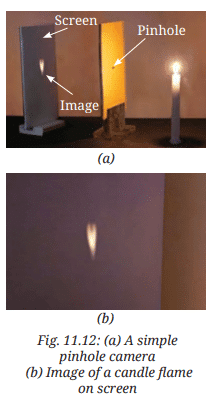
- What do you see on the screen? Light coming from the flame passes through the hole on the cardboard and forms an image of the candle flame on the screen. Do you notice anything surprising? The image of the candle flame is upside down, that is, inverted.
Ans:
- On the screen, you see an image of the candle flame formed by light passing through the small hole in the cardboard.
- The surprising observation is that the image of the candle flame is upside down (inverted). This occurs because light rays from the top of the flame pass through the pinhole and project to the bottom of the screen, and vice versa, due to the straight-line travel of light and the geometry of the pinhole.
Activity 11.10: Let us construct
Activity Description:
- Take two boxes of cardboard such that one can slide into another with very little gap in between them. Cut open one side of each box.
- On the opposite face of the larger box, make a small hole in the middle (Fig. 11.13a).
- On the opposite face of the smaller box, cut out a square from the middle with a side of about 5-6 cm. Cover this opening with a thin translucent paper (like a tracing paper) to form a screen (Fig. 11.13b).
- Slide the smaller box inside the larger one in such a way that the side with the tracing paper is inside (Fig. 11.13c).
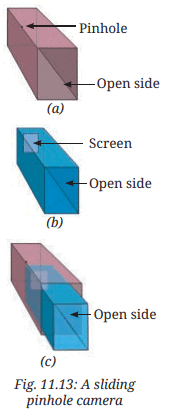
- Hold the pinhole camera with the pinhole facing the object and look through the open side of the smaller box. Cover your head and the camera with a dark cloth. Look at a distant object, like a tree or building, in bright sunlight and move the smaller box forward or backward until an image appears on the tracing paper.
- Do the images seen in the camera show the colours of the objects on the other side? Are the images erect or upside down?
Ans:
- The images seen in the pinhole camera show the colours of the objects on the other side, as the light passing through the pinhole carries the colour information of the object.
- The images are upside down (inverted). This is because light rays from the top of the object travel through the pinhole and project to the bottom of the screen, and rays from the bottom project to the top, resulting in an inverted image.
|
80 videos|322 docs|12 tests
|
FAQs on Class 7 Science Chapter 11 NCERT Based Activity - Light: Shadows and Reflections
| 1. What is the difference between a shadow and a reflection? |  |
| 2. How are shadows formed? |  |
| 3. What factors affect the size and shape of a shadow? |  |
| 4. Can shadows be colored? |  |
| 5. How do we see reflections? |  |
















